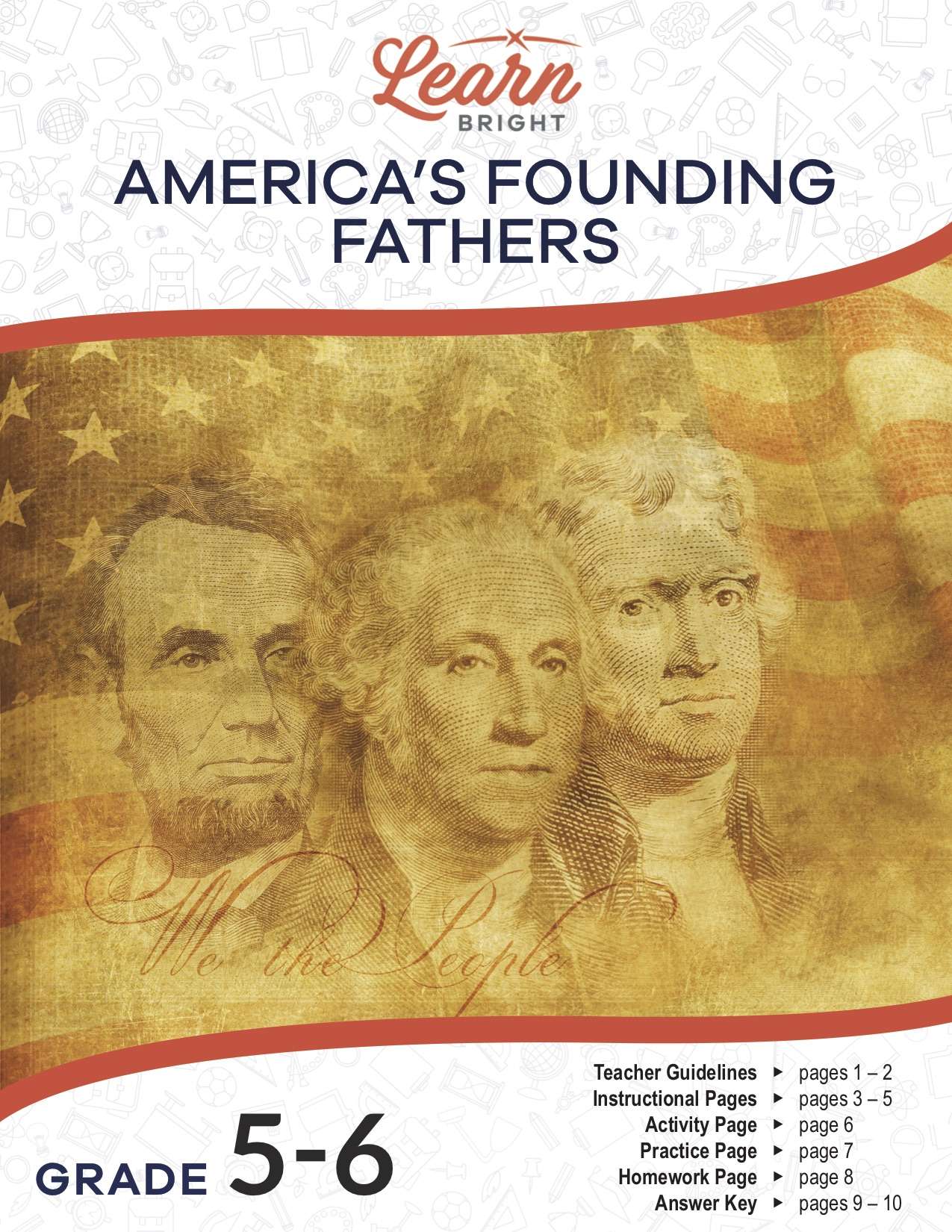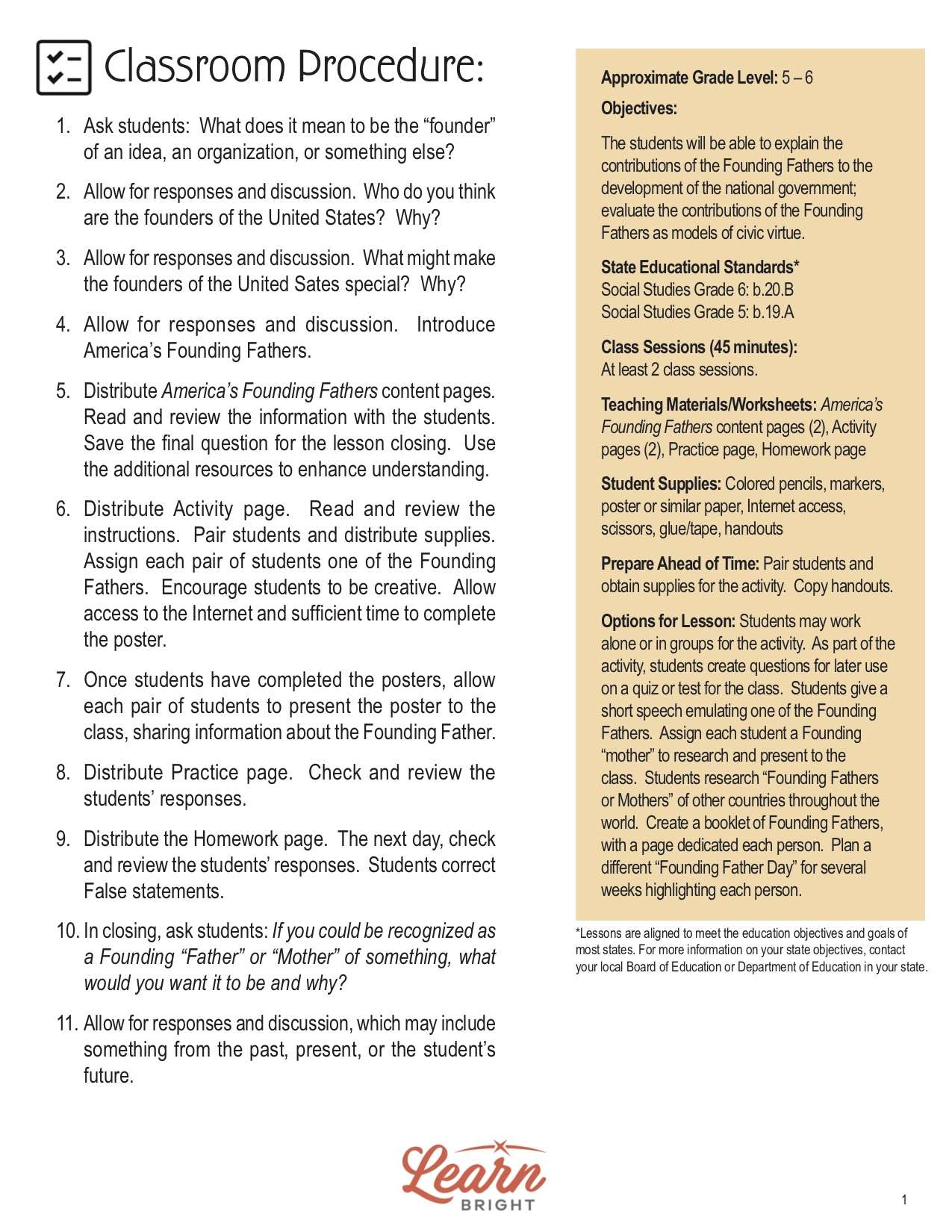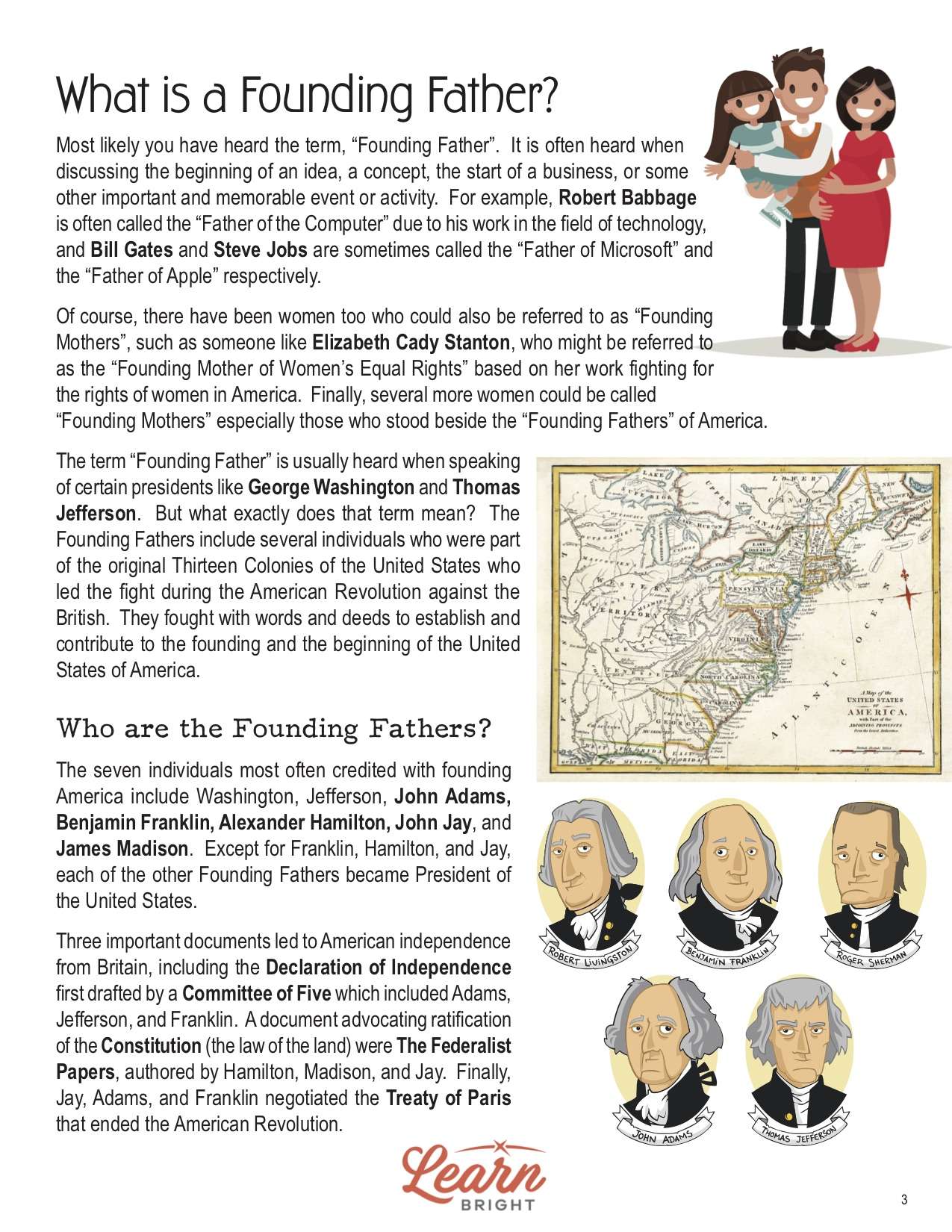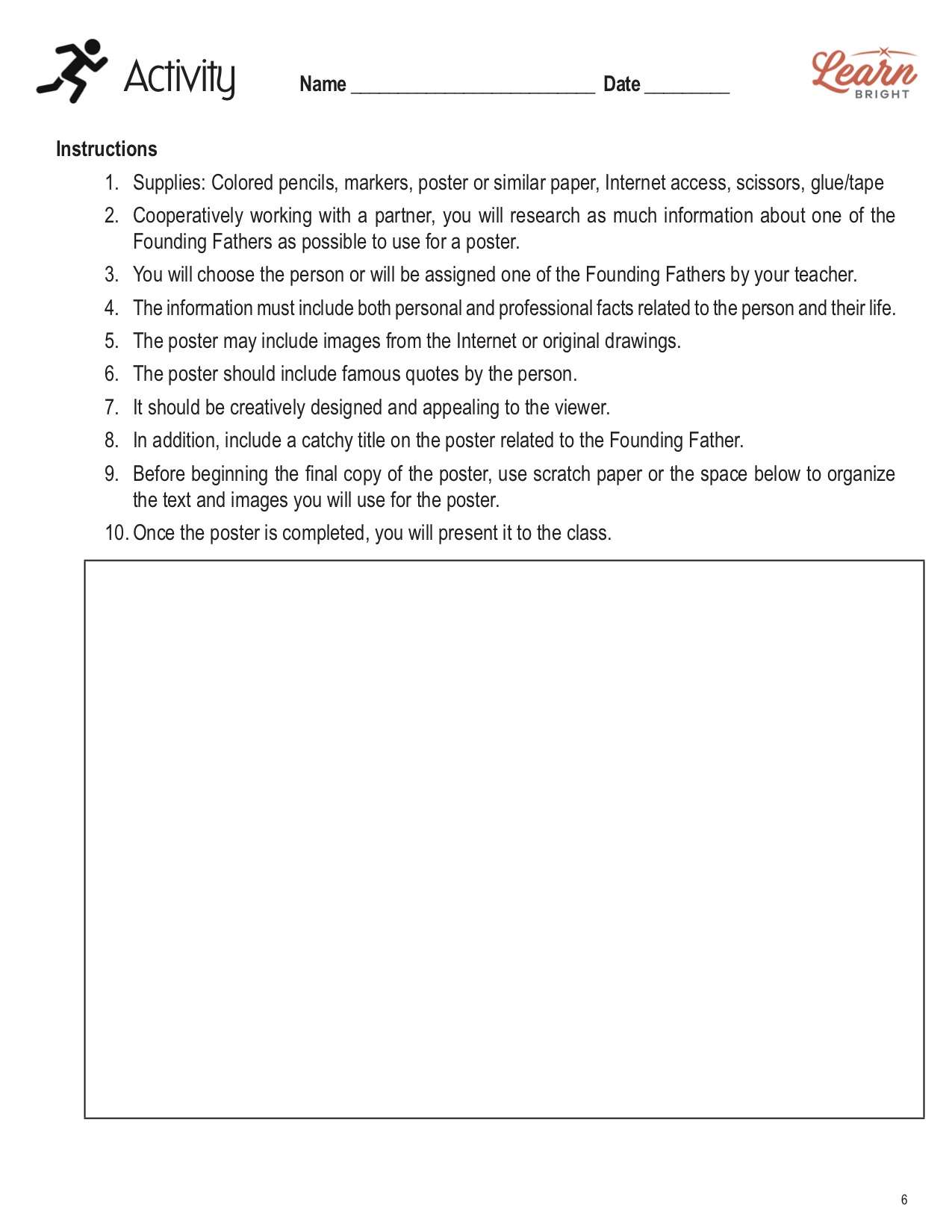Description
What our America’s Founding Fathers lesson plan includes
Lesson Objectives and Overview: America’s Founding Fathers delves into the Founding Fathers’ contributions to the development of the national government and their influence as models of civic virtue. This lesson focuses on seven statesmen responsible for American independence, as well as a few others, and their unique contributions to the effort. Students will be able to explain the contributions of the Founding Fathers to the development of the national government; evaluate the contributions of the Founding Fathers as models of civic virtue. This lesson is for students in 5th grade and 6th grade.
Classroom Procedure
Every lesson plan provides you with a classroom procedure page that outlines a step-by-step guide to follow. You do not have to follow the guide exactly. The guide helps you organize the lesson and details when to hand out worksheets. It also lists information in the orange box that you might find useful. You will find the lesson objectives, state standards, and number of class sessions the lesson should take to complete in this area. In addition, it describes the supplies you will need as well as what and how you need to prepare beforehand. For this lesson, you will need colored pencils, markers, poster or other paper, internet access, scissors, glue or tape, and the handouts. To prepare for this lesson ahead of time, you can pair students for the activity, gather the supplies, and copy the handouts.
Options for Lesson
Included with this lesson is an “Options for Lesson” section that lists a number of suggestions for activities to add to the lesson or substitutions for the ones already in the lesson. One optional addition to this lesson is to assign each student a Founding “mother” to research and present to the class, to recognize the contributions of women to the Revolutionary War and the founding of the U.S. You can find many other options on the bottom right of the Classroom Procedure page.
Teacher Notes
The teacher notes page includes a paragraph with additional guidelines and things to think about as you begin to plan your lesson. This page also includes lines that you can use to add your own notes as you’re preparing for this lesson.
AMERICA’S FOUNDING FATHERS LESSON PLAN CONTENT PAGES
What is a Founding Father?
This lesson includes three pages of content. The first section of this lesson explains to students what we mean when we call someone a Founding Father. Students will learn that when we call someone the “father” of something, we mean that they were instrumental in creating or developing that thing. Women can also be the “father” (or “mother”) of something! For example, we call Cady Elizabeth Stanton the “Founding Mother of Women’s Equal Rights” for her work fighting for the rights of women.
Within the context of the United States, being a Founding Father means that they were part of the original Thirteen Colonies and helped lead the fight against the British during the American Revolution. Each of these people were crucial in some way to the United States gaining its independence. These contributions could be through their actions, their words, or their ideas.
Who are the Founding Fathers?
The next section of this lesson delves into the specific Founding Fathers of America. Students will learn that we’ve most often given seven people this title: George Washington, Thomas Jefferson, John Adams, Benjamin Franklin, Alexander Hamilton, John Jay, and James Madison. Four of these men – Washington, Jefferson, Adams, and Madison – would go on to be President of the United States!
Students will also learn that there are three foundational documents that were a very important part of the U.S. gaining its independence from Britain. These are the Declaration of Independence, the Federalist Papers, and the Treaty of Paris. These were all created, authored by, or contributed to by some of the Founding Fathers.
Next, the lesson describes some of the roles that the Founding Fathers played in the founding of America and in running it once they had gained their independence.
Other Founding Fathers
The final section of this lesson describes some of the contributions and roles of some of the other Founding Fathers of America. Students will learn that we also consider Samuel Adams, Patrick Henry, John Marshall, and George Mason to be Founding Fathers! Some people also consider anyone who signed the Declaration of Independence to be a Founding Father.
Finally, the lesson notes that we have a large amount of information about most of the Founding Fathers. Many of them owned slaves, which complicates and stains their legacies. Despite this, they were all instrumental in gaining independence from the British and the birth and founding of the United States.
Key Terms
Here is a list of the vocabulary words students will learn in this lesson plan:
- Declaration of Independence: a very important document that was first drafted by the Committee of Five
- Committee of Five: this committee drafted the Declaration of Independence; Adams, Jefferson, and Franklin were part of this group
- Constitution: a document outlining the law of the land
- The Federalist Papers: a document advocating ratification of the Constitution; authored by Hamilton, Madison, and Jay
- Treaty of Paris: the document that officially ended the American Revolution; negotiated by Jay, Adams, and Franklin
- Commander-in-Chief of the Continental Army: a role held by George Washington
- Founding Fathers of U.S. Intelligence: Washington, Jay, and Franklin are considered this because of their early contributions to the intelligence and security systems of the U.S.
- Father of His Country: George Washington is referred to in this way because he played such an important leadership role as a part of the founding of America
- Poor Richard’s Almanac: an important best-selling book authored by Benjamin Franklin
- Chief Justice of the Supreme Court: the leader of the Supreme Court; John Jay was the first one
AMERICA’S FOUNDING FATHERS LESSON PLAN WORKSHEETS
The America’s Founding Fathers lesson plan includes three worksheets: an activity worksheet, a practice worksheet, and a homework assignment. You can refer to the guide on the classroom procedure page to determine when to hand out each worksheet.
POSTER ACTIVITY WORKSHEET
The activity worksheet for this lesson is a fun and creative assignment where students work with a partner. The pairs will create a poster that gives information about one of the Founding Fathers, as assigned by the teacher. They will first complete research on their assigned Founding Father using the internet or other sources. They will need to look for both personal and professional facts about them. Next, they will find images or create original drawings. They will also need to include famous quotes and make sure they’ve designed their poster well and that it is appealing to the viewer. They must also include a catchy title. Once they finish their poster, they will present it to the class.
Students many work alone or in groups for this activity, depending on your preference.
WHICH FOUNDING FATHER? PRACTICE WORKSHEET
For the practice worksheet, students will complete two exercises where they will have to determine which of the Founding Fathers participated in various activities. The first exercise has students list the Founding Fathers who helped write or sign three documents: the Declaration of Independence, the Federalist Papers, and the Treaty of Paris. Next, they will have to answer 15 “Who” questions with one or more of the Founding Fathers. For example, they will read the question “Who was the first president of the United States?” and will answer it with George Washington.
AMERICA’S FOUNDING FATHERS HOMEWORK ASSIGNMENT
The homework assignment has two sections. For the first section, students will answer various questions about the Founding Fathers. Some of these are short answer questions that will require students to really think through what they’ve learned during this lesson. Next, they will read various statements about the Founding Fathers and this time period in general. They will determine whether these statements are true or false.
Worksheet Answer Keys
This lesson plan includes answer keys for the practice worksheet and the homework assignment. Students’ answers for the first section of the homework assignment will vary, but the answer key provides some possible answers. No answer key is provided for the activity, as each pair’s poster will look different and include different information. If you choose to administer the lesson pages to your students via PDF, you will need to save a new file that omits these pages. Otherwise, you can simply print out the applicable pages and keep these as reference for yourself when grading assignments.










